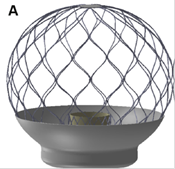Atrium Health’s Sanger Heart & Vascular Institute is Using 3D Printing Technology to Fix a “Leaky Valve” in the Heart
Atrium Health’s Sanger Heart & Vascular Institute is pioneering the use of new minimally invasive technologies to treat a variety of serious heart conditions. In December, Sanger’s clinical care team became one of the first teams in the United States and the world to implant a new device to treat a patient with heart valve issues. 
The team, comprised of Michael Rinaldi, MD; Markus Scherer, MD; Jonathan Schwartz, MD; and Eric Skipper, MD, implanted the AltaValve trans-catheter mitral valve replacement (TMVR) system in a patient with severe mitral valve insufficiency. The new technology, which is currently being used in clinical trials, offers a minimally invasive approach to treat qualified patients with mitral valve insufficiency who are not candidates for other procedures.
What is mitral valve insufficiency?
In a healthy heart, a series of valves ensure that blood flows forward and not backward when the heart is pumping. But in people with mitral valve insufficiency, sometimes also referred to as mitral regurgitation or a “leaky valve”, that doesn’t happen. Usually the problem is fixed with medication or surgery, but not all patients are candidates for these types of treatments. Until recently, this didn’t leave them with a lot of other options to successfully treat this serious heart condition. Now, there are a range of new non-surgical options available.
What are the symptoms and causes of a “leaky valve”?
Mitral valve insufficiency can cause increased blood pressure and fluid buildup in the lungs, leading to symptoms such as shortness of breath. In extreme cases, heart failure can occur.
Mitral valve insufficiency happens for a few different reasons. Sometimes, the leaflets in the mitral valve are broken and flop backwards; in other cases, the pumping chamber of the heart has a problem and that causes the leaflets in the valve to pull apart and not close properly.
Pioneering new minimally invasive technologies
The AltaValve device is created by the device manufacturer using a 3D printer and the patient’s cardiac CT scan, resulting in a valve that’s specific to each patient’s unique measurements.
The valve, which is housed in a springy metal ball, is delivered to the patient’s heart via catheter.
“These technologies are only used at very advanced centers,” says Dr. Rinaldi. “Our team includes a surgeon, interventional cardiologist, heart failure doctor, and advanced imaging cardiologist, all working together. There’s an exquisite amount of coordination, and we really tailor the right therapy to meet each person’s needs.”
The team at the Sanger Institute is experienced in using new techniques to fix heart issues – they have successfully used clip devices, aortic valve replacement, and other advanced techniques to treat heart conditions.
Learn more about Sanger Heart & Vascular Institute's heart valve treatment options here.
